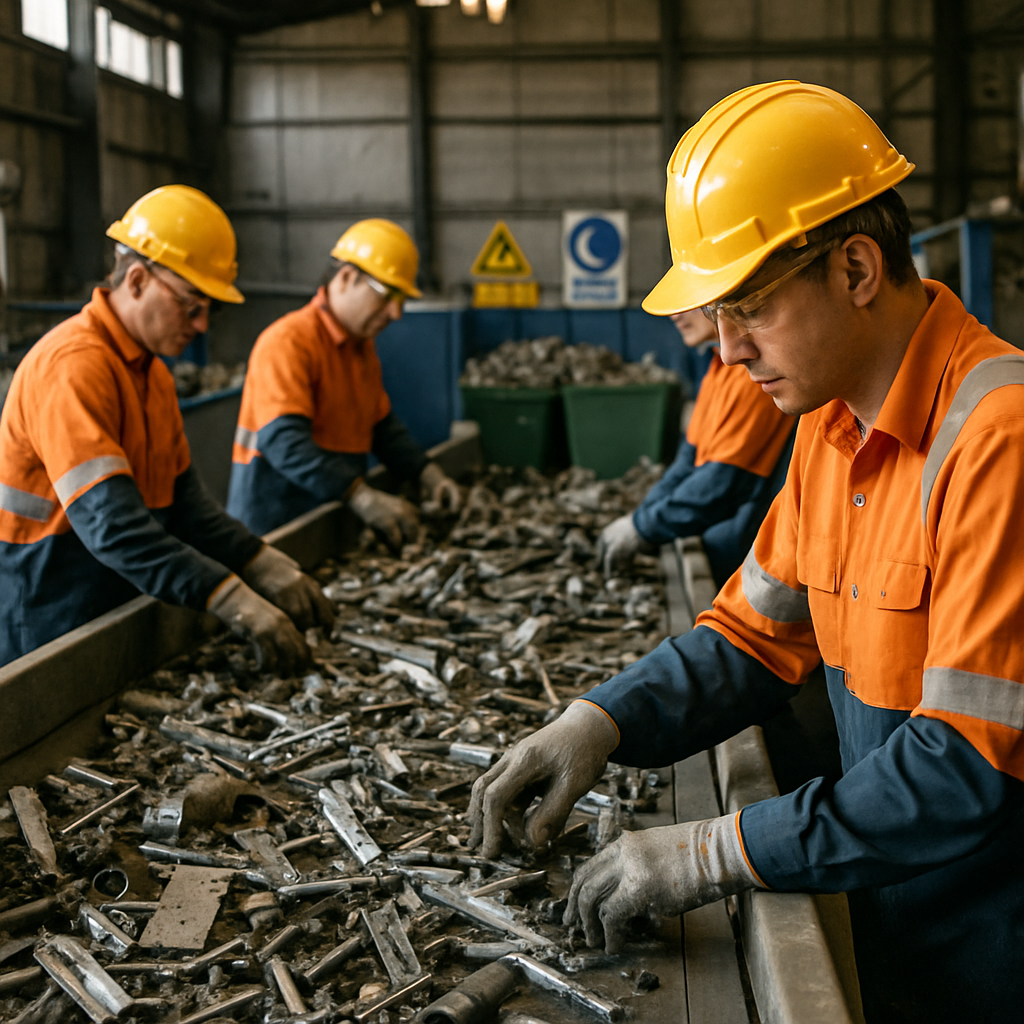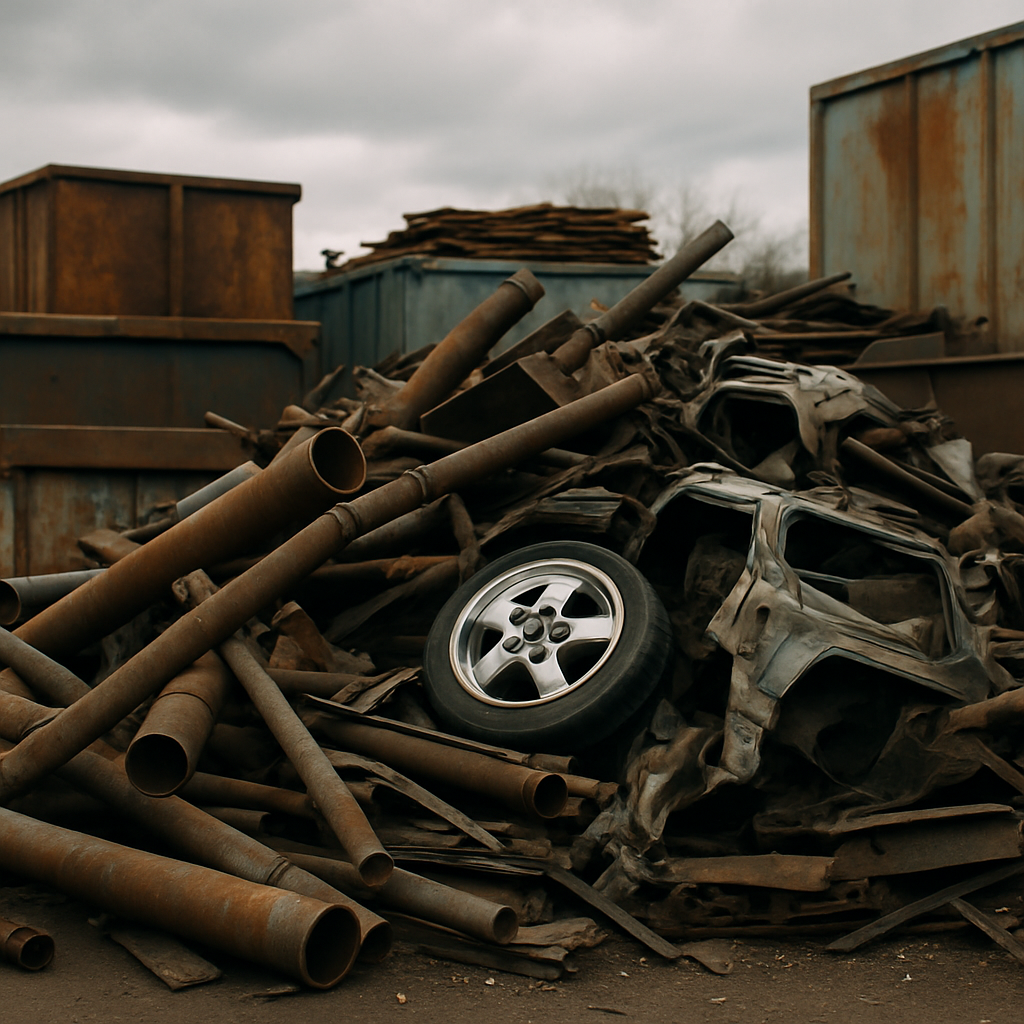5901 Botham Jean Blvd, Dallas, TX 75215
Metal and Steel Recycling: Process, Benefits, and Market Growth Trends
September 25, 2025Metal and steel recycling transforms discarded metal materials into valuable resources for new manufacturing. This process involves collecting metal waste, sorting it by type, processing it into reusable forms, and distributing it to manufacturers to create new products. From old appliances to construction debris, these materials are given a second life instead of filling landfills.
The economic impact of metal recycling is substantial. The global scrap metal recycling market reached $407.02 billion in 2023 and is projected to grow to $568.76 billion by 2032, with a steady annual growth rate of 3.8%. This growth reflects the increasing demand for sustainable materials and recognition of recycling’s economic benefits across industries.
Beyond economics, metal recycling offers significant environmental advantages. It conserves natural resources by reducing the need for virgin ore extraction. Recycling steel saves approximately 1.1 tons of iron ore, 0.6 tons of coal, and 0.05 tons of limestone for every ton processed.
How Does the Metal Recycling Process Work?

Metal recycling transforms discarded metal items into valuable resources through a systematic process. This efficient system not only diverts materials from landfills but also conserves significant amounts of energy compared to producing metal from raw ore. Let’s examine each step in detail.
Collection: The Critical First Step
The metal recycling process begins with collection. Scrap metal comes from various sources including construction sites, manufacturing facilities, and household items. Businesses often designate special bins specifically for metal waste to facilitate proper collection.
Collection points range from municipal recycling centers to specialized scrap yards that accept everything from small aluminum cans to larger metal components from vehicles and appliances. Some recycling facilities even offer transportation services for businesses with large volumes of scrap metal.
The effectiveness of this stage depends heavily on proper sorting at the source. Separating metals from other materials before collection significantly improves recycling efficiency.
Sorting and Separation: Identifying Recyclable Metals
Once collected, metals undergo rigorous sorting. This crucial step categorizes metals by type, composition, and recyclability. The main division is between ferrous metals (containing iron) and non-ferrous metals (like aluminum, copper, and brass).
Magnets play a key role in this process. Ferrous metals, which contain iron, respond to magnets, making separation straightforward. Non-ferrous metals require more sophisticated sorting techniques, such as sensor-based systems using infrared scanning or X-ray technology.
During this stage, recyclers also separate metals by color, weight, and purity level. Copper appears reddish, while aluminum has a silver tone. Lead feels heavier than aluminum when comparing similar-sized pieces. These distinctions help ensure accurate classification before processing.
Processing: Breaking Down for Efficiency
After sorting, metals enter the processing phase where they are reduced to smaller, more manageable pieces. Large hydraulic machinery compacts and squeezes bulky items to reduce their volume. Cutting equipment then breaks down these compacted pieces further.
Shredders and hammer mills transform the metal into smaller fragments. This step serves two purposes: it makes the subsequent melting process more efficient and creates a larger surface-to-volume ratio that speeds up melting.
The processing equipment varies depending on the type of metal. Specialized wire cutters remove insulation from copper wiring, while vehicle bodies require industrial crushers before entering shredders.
Purification and Melting: Transforming Scrap to Raw Material
Melting transforms the processed metal fragments into a reusable form. Large furnaces heat the metals to specific temperatures based on their composition. Different metals require different heat levels due to varying melting points and properties.
The purification process removes contaminants to ensure quality in the recycled product. Techniques include electrolysis, where an electric current passes through the molten metal to separate impurities. Some metals require magnetic separation to remove remaining non-metal particles.
While melting does require energy, it uses significantly less than extracting and processing virgin ore. For example, recycling aluminum uses approximately 95% less energy than producing it from bauxite ore.
Solidification: Creating New Metal Products
The final stage transforms the purified molten metal into usable forms for manufacturing. The molten metal may have specific chemicals added to create desired properties before cooling.
Conveyor systems transport the liquid metal to cooling chambers where it solidifies. Some metals form sheets while others become solid blocks through a process called baling. The specific form depends on the intended future use of the metal.
These solidified metals then move to manufacturing facilities where they become new products – from beverage cans to vehicle parts and construction materials. The cycle continues when these products eventually reach the end of their useful life and enter the recycling stream again.
Environmental Benefits Throughout the Process
Each step of metal recycling yields significant environmental benefits. The process reduces greenhouse gas emissions by up to 500 million tons compared to virgin metal production. It conserves natural resources, including soil, water, and air, while preventing toxic chemicals like mercury and lead from contaminating landfills.
Recycling metal uses up to 40% less water than mining operations and significantly reduces energy consumption. The Institute of Scrap Recycling Industries reports that recycled metal can be used infinitely without losing its properties, creating a truly sustainable material cycle.
What Are the Key Market Trends in Metal and Steel Recycling?

The metal and steel recycling industry is experiencing significant changes driven by environmental concerns, economic benefits, and technological innovations. Several key trends are shaping this market landscape in 2023 and beyond.
Asia Pacific dominates the global metal recycling market, holding over 51.9% of the market share, according to recent analyses. This leadership is primarily fueled by rapid industrialization and urbanization, especially in China and India. The construction boom across Asia has created substantial demand for recycled metals—China alone recycled over 213.7 million tonnes of steel in 2023. India has shown substantial growth, with recycled steel usage increasing by 11.5% to reach 29 million tonnes in the same period.
Ferrous metals, especially steel, are the largest segment in the recycling market, accounting for approximately 62% of total volume. This dominance arises from steel’s extraordinary versatility and ability to be recycled repeatedly without losing its properties. The construction sector remains the largest consumer of recycled ferrous metals, with building applications accounting for roughly 40% of recycled metal usage. This preference is driven by both cost-effectiveness and growing sustainability requirements in building codes.
The automotive industry is a critical driver of metal recycling growth. Vehicle manufacturers increasingly use recycled metals in production, with about 25% of materials used in car manufacturing now coming from recycled sources. This trend is expediting with the expansion of electric vehicle production, requiring substantial amounts of recycled aluminum and copper. The automotive sector’s commitment to sustainability is leading major manufacturers to set targets for recycled content, further stimulating market growth.
Technological innovation is enhancing the efficiency of metal recycling operations. Advanced AI-based sorting systems can now identify and separate different metal types with high accuracy. Sensor technologies using spectroscopy and computer vision allow facilities to process mixed metal streams faster while ensuring better quality output. These innovations address a significant challenge in the industry: the growing complexity of products containing multiple metal types that were previously difficult to separate.
Supply chain dynamics are also evolving, with an increased focus on developing closed-loop recycling systems. Major steel producers, like ArcelorMittal, have made strategic acquisitions of recycling companies to secure reliable scrap metal sources. For instance, in December 2022, ArcelorMittal acquired Riwald Recycling, a Netherlands-based ferrous scrap metal recycling business, showcasing this trend.
Environmental regulations continue to drive market growth, with many countries implementing stricter waste management policies. Programs like Extended Producer Responsibility (EPR) require manufacturers to take responsibility for products throughout their lifecycle, including end-of-life recycling. These regulatory frameworks are creating new opportunities for recycling businesses while encouraging manufacturers to design products with recyclability in mind.
As these trends converge, the global metal recycling market is projected to grow from $69.07 billion in 2024 to $110.18 billion by 2030, representing a compound annual growth rate of approximately 8.1%. This growth trajectory highlights the increasing importance of metal recycling in the global economy and its vital role in building a more sustainable future.
What Are the Environmental and Economic Benefits of Metal Recycling?

Metal recycling is a powerful strategy in combating climate change. Recycling metals instead of producing them from raw materials significantly reduces greenhouse gas emissions. For example, recycling one ton of steel prevents the release of 1.5 tons of CO2 into the atmosphere.
Conserving natural resources through metal recycling is crucial. Mining operations disrupt ecosystems and deplete finite resources. According to the EPA, recycling one ton of steel conserves 2,500 pounds of iron ore, 1,400 pounds of coal, and 120 pounds of limestone, preserving these resources for future generations.
Energy Efficiency: A Major Advantage
One of the most substantial benefits of metal recycling is energy savings. Manufacturing metals from recycled materials requires far less energy than production from virgin sources. For instance, recycling aluminum saves 95% of the energy compared to processing it from bauxite ore. Steel recycling cuts energy consumption by 60-70%, and copper recycling conserves roughly 85% of the energy needed to mine and process new copper.
These energy savings have tangible impacts. Recycling a single aluminum can conserves enough energy to power a 100-watt light bulb for four hours. Across the industry, metal recycling reduces greenhouse gas emissions by approximately 29 million tons of CO2 annually, equivalent to removing 6.3 million cars from the roads.
Economic Growth Through Job Creation
The economic benefits of metal recycling go beyond cost savings. The industry creates more jobs than traditional waste disposal methods. Research indicates recycling can generate up to 10 times more employment opportunities than landfilling or incineration for the same amount of material.
These jobs span the entire recycling supply chain, offering diverse employment opportunities for individuals with various skills and educational backgrounds. According to the Institute of Scrap Recycling Industries, the recycling industry contributes over $105 billion annually to the U.S. economy.
Cost-Effective Raw Materials
For manufacturers, using recycled metal offers a significant competitive advantage. It substantially reduces production costs compared to using virgin ore. These savings help manufacturers stabilize budgets against the volatility of global metals markets while maintaining competitive pricing.
Notably, recycled steel comprises about 40% of global steel production. This widespread use is driven by both environmental awareness and economic sense. Unlike many materials that degrade during recycling, metals retain their essential properties through unlimited recycling cycles, making them ideal for sustainable practices.
Businesses that implement metal recycling programs also benefit from reduced waste disposal costs. By diverting metal from waste streams, companies lower their trash pickup and disposal fees. Manufacturing facilities producing substantial metal waste can achieve significant savings through these reductions.
Supporting Sustainability Goals
Metal recycling assists organizations in meeting crucial sustainability standards. As environmental regulations become stricter globally, businesses with effective recycling programs gain competitive advantages through reduced carbon taxes and improved regulatory standing.
The recycling industry dramatically reduces water consumption compared to primary metal production. Extracting metals from raw ore requires vast amounts of water for processing and cooling. Recycling significantly reduces water use, helping conserve this precious resource.
Recycling keeps metals in circulation, reducing the need for new mining operations that disrupt habitats and biodiversity. This protection helps maintain the ecological balance necessary for healthy ecosystems while supporting long-term economic stability.
The environmental and economic benefits of metal recycling create a powerful synergy, demonstrating that sustainable practices can support both ecological and financial goals. Each recycled metal product contributes to a more sustainable and economically resilient future.
Conclusion: The Future of Metal and Steel Recycling

The metal and steel recycling industry is poised for significant growth. As environmental awareness increases globally, there is a stronger demand for sustainable materials in manufacturing and construction. Regulatory pressures are mounting worldwide, prompting industries to embrace circular economy principles and reduce carbon footprints through recycling efforts.
Technological innovation is reshaping the recycling sector. Advanced sorting systems utilizing artificial intelligence, enhanced metal analysis techniques, and automated processing make recycling more efficient and cost-effective. These advancements will improve metal recovery rates and quality, ensuring recycled materials meet the highest standards for reuse in new products.
For your metal and steel recycling needs, contact Okon Recycling at 214-717-4083. Our experienced team can assist in implementing effective recycling solutions that benefit both your organization and the environment.
